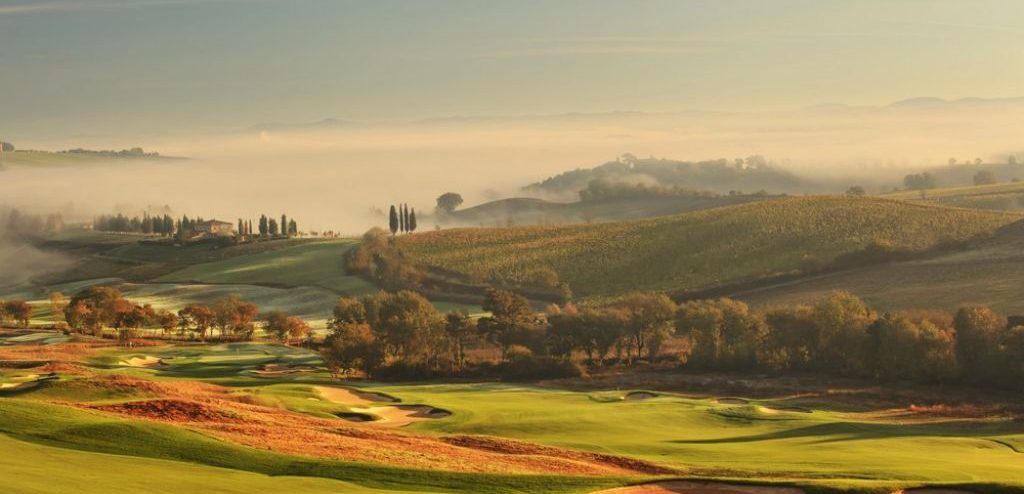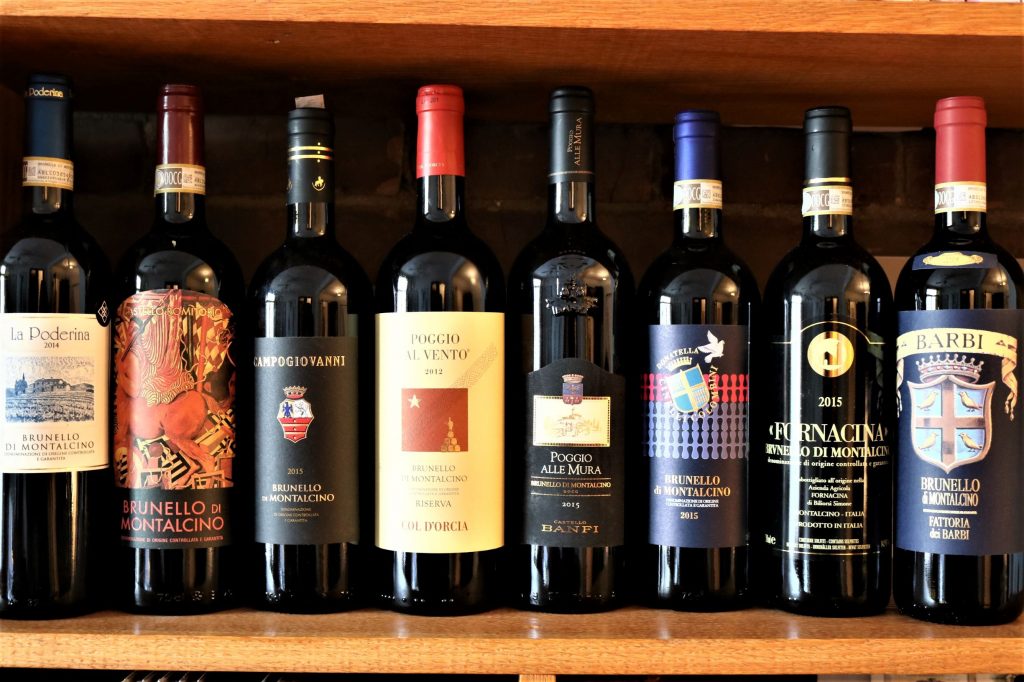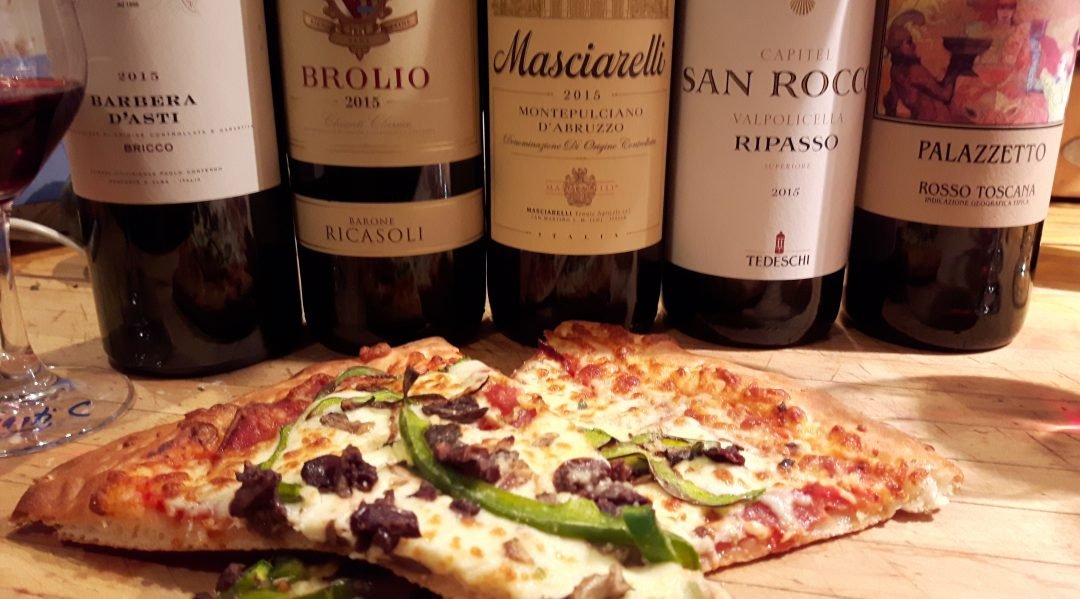In the 1970s, the Tuscan municipality of Montalcino was home to some 30 wineries producing DOC-level red wines sold primarily within Italy. Now, the region boasts well over 200 producers and bottlers. Elevated to the coveted DOCG status in 1980, Brunello di Montalcino wines are among the most sought after Italian wines today.
Side note: This Brunello di Montalcino wines article was also produced as a sponsored video (in partnership with the Consorzio del Brunello di Montalcino). To watch, just scroll down to the bottom and click play. If you enjoy the video, consider subscribing (click here) to my YouTube wine education channel so you never miss an episode.
Montalcino lies forty kilometres south of Siena and roughly 50 kilometres inland from the Tyrrhenian Sea. This fortified, medieval town is perched atop a lone hill that rises from the gentle pasture lands of the Unesco World Heritage Val d’Orcia region. It is from the vineyards that surround Montalcino that the fabled Brunello di Montalcino wines are produced.
Among the rolling pasture lands of the Val d’Orcia, rises a lone hill. Perched near the top is the medieval village of Montalcino.
Montalcino enjoys a warm, dry Mediterranean climate. The region is sheltered from rain and hail by Mount Amiata to its south east. Conditions are cooler at higher elevations. From mid-slope to the higher reaches, a significant difference in day to nighttime temperatures slows down vine ripening. This results in ripe, concentrated, tannic wines ably balanced by fresh acidity.
Many millions of years ago most of Italy was underwater. Tuscany lay under a shallow sea with the top of Montalcino emerging like a small island in its midst. Over the span of numerous geological eras, the oceans receded and returned in the area around Montalcino, causing massive landslides pulling soils from the summit toward the middle of the hill.
These influences, coupled with volcanic activity from the now extinct Mount Amiata, created an incredible diversity of soils in the region. Lower lying vineyards have lighter, more fertile, alluvial soils for the most part, whereas higher vineyard sites tend to be rockier, with limestone and marl-rich soils.
Many millions of years ago Tuscany lay under a shallow sea, with the top of Montalcino emerging like a small island in its midst.
The commune of Montalcino spans over 31 000 hectares, with a mere 15% devoted to grape vines. Forests, olive groves, and seeded crop lands cover much of the territory. While international demand is high, the Consorzio del Vino Brunello di Montalcino (the grower and winery consortium for Brunello di Montalcino wines) only permits a 3% annual increase in total vineyard acreage so as to protect the region’s rich biodiversity.
Whereas many Tuscan Sangiovese strongholds allow blending in of secondary grape varieties, Brunello di Montalcino wines are made exclusively from Sangiovese. Historically, one specific group of Sangiovese clones (referred to locally as ‘Brunello’, or more specifically ‘Sangiovese Grosso’) was planted. This is no longer the case.
Sangiovese Grosso grapes have a high pulp-to-skin ratio. Given that the highest concentration of phenolic (colour, tannins) and flavour compounds are found in the skin, a higher skin-to-pulp ratio is favourable for truly concentrated, complex wines. Nowadays, a large variety of clonal selections exist in Montalcino; a boon to both quality and stylistic diversity.
Whereas many Tuscan Sangiovese strongholds allow blending, Brunello di Montalcino wines are made exclusively from Sangiovese.
Brunello di Montalcino wines are aged for 5 years before release (with a minimum of 2 years in oak casks). Even more premium, are the Brunello ‘Riserva’ wines which see a full 6 years’ maturation. Traditionally, large Slavonian oak botti (one to ten thousand litre casks) were used for ageing. Nowadays, Brunello producers use both Slavonian botti and French oak barrels of varying sizes.
Brunello di Montalcino wines offer red and dark fruit aromas, underscored by dried herbs, and balsamic notes. They are fresh and full-bodied on the palate, with concentrated, ripe fruit flavours, and muscular tannins. Due to their complexity and structure, Brunellos have excellent ageing potential, softening and developing attractive dried floral, fig and leather flavours over time.
Due to their complexity and structure, Brunello di Montalcino wines have excellent ageing potential, softening and developing attractive tertiary flavours over time.
While waiting for Brunello di Montalcino wines to mature, enthusiasts can sip on the region’s “second wines”; namely Rosso di Montalcino DOC. Made from younger plantings of Sangiovese, or from less favourable vineyard sites, Rosso di Montalcino wines are aged for just one year before release.
Dubbed “baby Brunello” by many producers, these early-drinking reds are a great foreshadowing of the potential of a Brunello vintage. They have similar aromas and flavours, but are lighter in body and structure, with softer tannins.
In preparation for a series of masterclasses on the region, I had the great pleasure of chatting with a number of Montalcino winemakers and winery owners. The impression I got was of a dynamic region, with a firm focus on sustainable viticulture and winemaking practices, and a growing contingent of women in leadership positions.
Donatella Cinelli Colombini shared her story of hiring an oenologist back in the days where male winemakers were in high demand while their female counterparts were decidedly not! That realization led her to create an all women winery team; an initiative that has inspired women throughout the region.
Il Paradiso di Frassina winemaker, Federico Ricci, spoke of their Mozart in the vineyards project (see more here). Castello di Banfi general manager, Enrico Viglierchio, detailed the important clonal research the winery has undertaken to isolate top quality Sangiovese clones.
Many more fascinating tales were told, and at the heart of each discussion, were the themes of increasingly organic vineyard practices and measures undertaken to reduce vineyard and winery carbon footprint.
The best way to experience Rosso and Brunello di Montalcino wines is glass in hand, wandering through the vineyards on a sunny day in Tuscany. Unfortunately, for now we must use our imagination and travel through our tastings.
The Montalcino region has been blessed with a number of excellent to outstanding vintages in recent years. Our masterclass wines included the highly varied 2012, 2014, and 2015 vintages of Brunello di Montalcino wines, as well as the 2018 and 2019 Rosso di Montalcino vintages.
2012: 5-star vintage. Rich, concentrated wines that show a fine balance between ripe fruit flavours and vibrant acidity. Exceptional cellaring potential. Hold.
2014: 3-star vintage. Cool, rainy growing season that produced a smaller than average crop. Light, finely chiselled wines with bright fruit and tangy acidity. Drink now.
2015: 5-star vintage. Warm summer with cool overnight temperatures resulting in ripe, rich wines with balanced freshness, and powerful tannic structure. Hold.
2018: 4-star vintage. Summer heatwaves followed by cooler, rainier weather near harvest. The wines are shaping up to be elegant and silky, with a charming, upfront fruit profile. Rosso: drink now. Brunello: not yet released.
2019: 5-star vintage. A warm season with slow, even ripening. The wines look to be very fruit-forward, with ripe tannins, and lots of finesse. Rosso: drink now/hold 1 year. Brunello: not yet released.
Check out these excellent Brunello producers: Altesino, Caparzo, Il Paradiso di Frassina, Carpineto, La Poderina, Castello Romitorio, Campogiovanni (San Felice), Col d’Orcia, Castello Banfi, Donatella Cinelli Colombini, Fornacina, Fattoria dei Barbi




